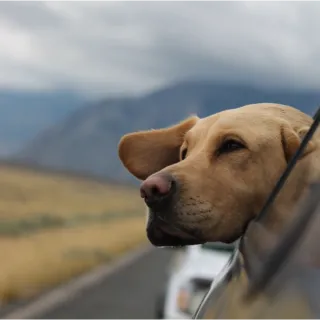The Ultimate How-To Guide for Grooming Dogs at Home by John Woods
This is a guest post on the Grey Matters Blog and not written by anyone affiliated with Grey Muzzle. We allow guest contributors from time to time in order to provide our supporters with a wide range of topics pertaining to senior dogs.
We all know that we should regularly groom our canine companions at home; whether this is bathing, brushing or giving them a good check over their eyes, ears and teeth. With some dogs, this is easier said than done, especially for long haired active breeds, here we have put together an ultimate guide for grooming your dog at home.
Grooming From a Young Age
Ideally, grooming should be introduced to your puppy as early as possible – we’re not talking full blown bathing and hair drying the day you bring them home but handling and exposing them to the sensations and sounds of the grooming tools and methods.
Start slowly, just handling the different parts of their bodies; their ears, tail, tummy and especially their paws! The sooner you can get your pup to accept his paws being touched, the happier your groomer will be and the less stressful you’ll find any grooming routine! Praise and reward regularly – if pup isn’t a fan of being touched in certain places, ask a helper to ply him with treats, or give him a chew to keep him occupied. Some owners have great success popping a spoonful of dog-safe peanut butter on a kitchen unit or in the bath for him to lick off during grooming. (Ensure the peanut butter doesn’t contain Xylitol as this is toxic to dogs).
Dog’s learn from the consequences of their behaviour – that is, if they experience a positive consequence, they are more likely to repeat said behaviour. If they know that their grooming routine is a positive experience, they are more likely to accept it, and dare we say it, even enjoy it!
Socialize Your Dog With Grooming Tools
Once you are confident that pup accepts being held and touched, you can introduce the tools of your trade!
These of course vary, depending on the breed of dog you have, but we’ll share some of our top tools for the job!
The Metal Comb – a staple that any dog owner should have in their draw. This is great for regularly combing through their coat and keeping it knot and Matt free. We recommend a metal comb as it will last, and you can easily sanitize and disinfect it!
The Slicker Brush – this is great for curly coated breeds! We’re talking any of the Doodles, Poodles, Bichon Frise and Maltese type coats. You can usually buy soft or hard slicker brushes, if you keep your curly coat a little longer, then the hard-slicker brush is a good choice, if on the other hand you clip your curly coat short, invest in the softer brush.
The Rake – this is your tool of choice for those double coated breeds; the German Shepherd or Akita for example. It removes impacted undercoat and keeps those longer coats knot and Matt free. The rake is also great for combing leave in conditioner through those longer coats, before finishing with the comb.
Rubber paddle brush – there are plenty on the market, you’ll immediately identify them as they have rubber nobbles across them. These are brilliant for Labrador coats or short, sleek coats like Staffordshire Bull Terrier or Whippet coats! The rubber material grips to the hair as you brush them, which drags loose hair from the body. You can also use them to massage shampoo in during bath time! Two birds, one stone!
The De-matting Knife - not quite as brutal as it sounds, the de-matting knife is sometimes the kindest way to remove knots and matts from a coat. With some leave in conditioner or de-tangler, the de-matting knife simply cuts the knot or matt from the coat. It will only remove the hair that’s tangled together, so you can be totally confident when using this!
Again, introduce whichever tools you are using for your breed, slowly and with plenty of praise and reward. Start with short bursts, a couple of minutes here and there, slowly increasing. The idea is to make the experience as positive as possible, so your pooch will at least accept that it’s a part of their routine.
As they grow, how much you groom your pooch will depend on their breed. Double coated breeds should ideally be brushed 2-3 times per week. Curly coats which easily matt should be brushed daily. If you decide to take your dog to be professionally clipped by a groomer, they will advise you on the best schedule to maintain their coat between grooms.
Make Sure to Clean Their Ears, Eyes and Teeth Too
Grooming not only includes brushing and bathing, but cleaning ears, eyes and brushing their teeth. You should regularly check their eyes for deposits and clean them with a wash cloth, or even some dog safe eye wipes. Also, clean their ears, this can easily be done with dampened cotton wool, or with specific ear cleaner.
Many dogs with curly coats will need their ears plucked – again, not as brutal as it sounds, this often prevents ear infections in those prone to them; think Poodles or any of the Poodle crosses. If you aren’t comfortable or confident doing this, ask your groomer to show you, or just book more regular visits so they can keep on top of it.
Teeth brushing should have also been introduced from puppyhood – studies have shown than one brushing per week shows little improvement in plaque or tartar formation, so you need to be doing this a few times a week!
If your pup accepts it as a tolerable or a potentially enjoyable experience, it makes it a lot less stressful to repeat several times a week. For both of you!
How you groom your pooch, and how often all depends on their breed. If you are unsure, speak with a qualified groomer. The best chance you have at successful grooming at home is to introduce it as young as possible, with as much positive reinforcement and reward as possible. If they enjoy it, they’re more likely to let you do it!
About the Author:
John Woods is a recognized author by the Dog Writers Association of America and spends most of his free time training dogs!


